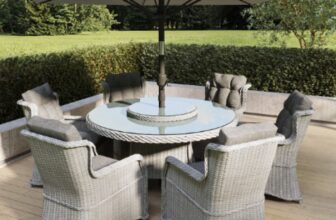
Small Space, Big Style: Tips for Elevating Home Aesthetics
Key Takeaways:
- Home aesthetics are not merely about the visual; they influence emotions and contribute to overall well-being.
- Strategic choices in colors, lighting, and arrangements can have a transformative impact on home ambiance.
- Textures, plant life, and personalized decor enrich the home’s character and narrative.
Table of Contents:
- Introduction to Home Aesthetics
- Color Schemes and Mood
- The Art of Lighting
- Furniture Selection and Arrangement
- Texture and Materials
- Decorative Accessories and Art
- Creating a Focal Point in Each Room
- The Role of Greenery and Natural Elements
- Balancing Functionality and Style
- The Finishing Touches: Detail and Personalization
Introduction to Home Aesthetics
Enviable home aesthetics is a curated blend of balance, harmony, and personal expression within a domestic space. The striking cohesion of elements transcends simple decor, nurturing a haven that is simultaneously welcoming and a reflection of one’s tastes. Understanding and implementing foundational home design principles, influenced by design visionaries, elevates living from the mundane to the sublime. Aesthetic value in a home engages the senses and sparks joy—elements of color, texture, and arrangement synergize to create an environment conducive to vitality and relaxation. The psychological impact of a thoughtfully designed space emphasizes the interaction between individuality and design elements. Perhaps, most importantly, aligning a home’s aesthetic with the owner’s values and lifestyle transforms a simple space into a profound sanctuary.
Color Schemes and Mood
The color palette is the silent narrator of your home’s story, influencing the narrative of each room with its nuanced hues. Understanding the relationship between color and mood is essential for creating desired ambiances, as colors can kindle a spectrum of emotions—from the vivacity of reds to the tranquility of blues. Thoughtful consideration of a room’s orientation, lighting, and function will guide the choice of color schemes that resonate with intent and context.
Moreover, exploring the psychological underpinnings of color perception can be enriching. The strategic use of colors can bolster the room’s purpose; for instance, a study might benefit from the concentration-boosting effects of green, while a bedroom might call for calming lavender tones to promote relaxation.

Accent colors serve as dynamic players, creating contrast and vibrancy, breathing life into a monochromatic base, or calming a vivid array of shades.
The Art of Lighting
Proper lighting has the transformative capacity to elevate a home from the realms of the ordinary to the extraordinary. Adequate lighting is multifaceted—it’s about beauty, mood-setting, task facilitation, and the enhancement of other design elements. Thoughtful choices about the types and placements of light fixtures can add depth, eliminate unwanted shadows, and highlight artistic features or the lovely mingling of textures across the space. The balance and character of lighting within a space significantly influence our experience—the warmth of ambient lighting can draw us into a state of calmness ideal for living spaces. In contrast, the clarity of task lighting supports focus and efficiency in workspaces. Subtle adjustments in lighting can tailor atmospheres to match the tempo and tone of occasions, moods, or times of day, making it an invaluable tool in the home aesthetic toolkit.
Furniture Selection and Arrangement
By wisely selecting furniture, one dictates the functionality and flow of space while enriching it with personal style. Furniture speaks to comfort and usability but also serves as a powerful art form in its own right—the silhouettes, materials, and patterns chosen should resonate with the overarching theme of the home. Each piece needs to maintain intrinsic aesthetic appeal while contributing to the collective beauty of the space. The alignment of furnishings is equally significant. It should cultivate a dialogue between pieces while facilitating social interaction and movement through the room. This strategic placement includes ensuring proper circulation pathways and using furniture to guide attention organically to the central focal points of the room. Whether through symmetry or a more eclectic approach, the furniture arrangement is central to creating an inviting and functional habitation.
Texture and Materials
Textures infuse spaces with dimensions unknown to color alone. They invite touch, play with light, and convey character. Layering varied textures—smooth, rough, plush—gives a space complexity and warmth. Materials equally contribute to a home’s narrative. The alluring glow of polished metal, the earthen comfort of terracotta, or the natural breathability of cotton—each material tells its own story and aids in crafting a rich sensory experience. Choosing materials and textures is an intimate design decision, with sustainability, longevity, and care considerations taking center stage.

Incorporating diverse textures within a cohesive aesthetic framework takes consideration and foresight. When struck just right, this balance allows for a dynamic, tactile environment that stands the test of time and trend.
Decorative Accessories and Art
Decorative elements and artworks are the signature touches that turn empty walls and surfaces into expressions of personal heritage, interests, and style. Artwork, whether traditional paintings, modern sculptures, or artisanal crafts, imbues spaces with a sense of culture and depth. Accessories, be they ornate or minimalist, narrate the stories of the inhabitants—each piece selected should be a token of a personal journey or a testament to individual design preferences.
However, restraint is often as necessary as selection in accessorizing. The goal is to curate rather than clutter, to enhance rather than obscure, creating a visual dialogue between space, form, and the person who inhabits it. Shelves and tables become showcases for meaningful pieces that elevate a home beyond the ordinary, offering glimpses into the memories and dreams of those who dwell within.
Creating a Focal Point in Each Room
The alchemy of creating a focal point lies in its capacity to command attention and serve as an orienting feature within a space. Focal points give a room structure and identity by establishing a dominant feature, whether a statement artwork above a mantle or an arresting area rug. They are the anchors around which all other elements convene, and they guide the eye, subtly dictating the hierarchy of visual importance within the room. Identifying or crafting a focal point can be an exercise in creativity—it may arise naturally from architectural details or require an injection of drama through bold design choices. Subtle enhancements, such as strategic lighting or contrasting color applications, can amplify a focal point’s impact, cementing its role as a centerpiece worthy of admiration and engagement.
The Role of Greenery and Natural Elements
The infusion of greenery into living spaces is more than a mere aesthetic choice—it’s a lifestyle orientation that embraces vitality, renewal, and the intrinsic beauty of the natural world. Plants serve as living decor, changing with the seasons and growing with care, introducing a dynamic element to a home’s design. The selection of vegetation should harmonize with the home’s lighting, climate, and caretaker’s capacity, culminating in a verdant display that is as sustainable as it is beautiful. The tactful incorporation of natural elements extends beyond potted flora, venturing into organic materials. Using raw textures in wood, wicker, and earthenware creates a layered, grounded, and ethereal aesthetic. These materials echo the outdoors, bringing a piece of the natural world indoors and fostering a serene and stimulating environment.
Balancing Functionality and Style
A home must be styled not only for the eyes but for the realities of everyday life. A regal dining table holds more than feasts—it is a hub for family gatherings; overstuffed chairs offer retreats for intimate conversations. The intersection of functionality and style is a delicate path where practicality meets art.

Designs should accommodate the ebb and flow of domestic life, with spaces tailored to their inhabitants’ unique rhythms and routines. Furnishings and decor must captivate imaginations and withstand the wear and patina of life’s moments. In choosing materials and designs, anticipate interaction—surfaces that will see frequent touch, seating that will welcome weary bodies, and pathways that must withstand the tread of countless footsteps. This understanding allows the essence of style to embrace everyday life, offering a stage upon which every day’s theatre can unfold with grace and utility.
The Finishing Touches: Detail and Personalization
The quintessence of detail and a devotion to personalization elevates a space from simply functional to entirely poetic. These touches—a curated collection of postcards on a refrigerator, a hand-woven blanket draped over a chair, a bouquet of fresh flowers on a windowsill—breathe authenticity and warmth into your abode. They stand as testaments to life lived and loved, encapsulating the ephemera of personal history and the evolving narrative of home. As dwellings evolve, so too should the elements within—continually embracing new inspirations, accommodating life’s milestones, and reflecting the current chapter in one’s journey. Such is the culmination of details that frame the everyday, offering silent testimony to the unique individuals who create, inhabit, and cherish their sanctuaries daily.
Resources:
Minimalist design tips: How to make a small space look bigger
https://decormatters.com/blog/maximizing-small-spaces-room-design-solutions-for-tiny-rooms



















































































